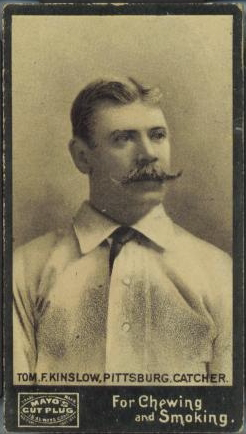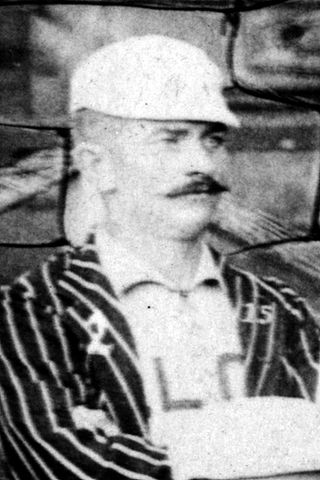Related Research Articles

The National League of Professional Baseball Clubs, known simply as the National League (NL), is the older of two leagues constituting Major League Baseball (MLB) in the United States and Canada, and the world's oldest extant professional team sports league. Founded on February 2, 1876, to replace the National Association of Professional Base Ball Players (NAPBBP) of 1871–1875, the NL is sometimes called the Senior Circuit, in contrast to MLB's other league, the American League, which was founded 25 years later and is called the "Junior Circuit". Both leagues currently have 15 teams.
The American Association of Base Ball Clubs (AA) was a professional baseball league that existed for 10 seasons from 1882 to 1891. Together with the National League (NL), founded in 1876, the AA participated in an early version of the World Series seven times versus the champion of the NL in an interleague championship playoff tournament. At the end of its run, several AA franchises joined the NL. After 1891, the NL existed alone, with each season's champions being awarded the Temple Cup (1894–1897).
The Players' National League of Professional Base Ball Clubs, popularly known as the Players' League (PL), was a short-lived but star-studded professional American baseball league of the 19th century. The PL was formed by the Brotherhood of Professional Base Ball Players in November 1889, after a dispute over pay with the National League (NL) and American Association (AA). The NL had implemented a reserve clause in 1879, which limited the ability of players to negotiate across teams for their salaries; both the AA and NL had passed a salary cap of US$2,000 per player in 1885, equivalent to $52,844 in 2021; the owners of the NL had agreed to remove the salary cap in 1887 but failed to do so. Major League Baseball (MLB) considers the PL a "major" league for official statistical purposes.

Amos Wilson Rusie, nicknamed "the Hoosier Thunderbolt", was an American right-handed pitcher in Major League Baseball during the late 19th century. He had a 10-season career in the National League (NL), which consisted of one season with the Indianapolis Hoosiers in 1889, eight with the New York Giants from 1890 to 1898, and one with the Cincinnati Reds in 1901.

The Philadelphia Athletics were a professional baseball team, one of six charter members of the American Association, a 19th-century major league, which began play in 1882 as a rival to the National League. The other teams were the Baltimore Orioles, Cincinnati Red Stockings, Eclipse of Louisville, Pittsburgh Alleghenys, and St. Louis Brown Stockings. The team took its name from a previous team, which played in the National Association from 1871 through 1875 and in the National League in 1876.

Charles G. Buffinton was an American right-handed pitcher in Major League Baseball from 1882 to 1892. One of the workhorse pitchers of the 1880s, he won 20 games seven times and his 1,700 career strikeouts are the ninth-highest total of the 19th century.

John Elmer Stivetts was an American professional baseball pitcher who played 11 seasons in Major League Baseball (MLB) spanning from 1889 to 1899. He played in the American Association (AA) with the St. Louis Browns, and in the National League (NL) with the Boston Beaneaters and Cleveland Spiders. "Happy Jack" was born to German immigrants and raised in Ashland, Pennsylvania. He initially followed his father into the coal mining industry before playing professional baseball. After playing two and half seasons in minor league baseball, he was signed by the Browns. Over the next few seasons, he was regarded as one of the best pitchers in baseball.
The following are the baseball events of the year 1890 throughout the world.
The following are the baseball events of the year 1889 throughout the world.
The following are the baseball events of the year 1887 throughout the world.
The following are the baseball events of the year 1883 throughout the world.

Forepaugh Park was a baseball ground located in Philadelphia, Pennsylvania, at Broad and Dauphin Streets in North Philadelphia. It had an estimated capacity of 5,000. The ground was home to the Philadelphia Quakers of the Players' League in 1890 and the American Association in 1891. The ballpark featured a bicycle track and was a popular velodrome in Philadelphia in the early 1890s. The ballpark was owned by and named for Adam Forepaugh and the grounds used for circuses and various types of exhibitions until 1894. The property was sold for development and residences constructed in 1895.

George Edward Andrews was an American professional baseball player. He was a right-handed second baseman and outfielder over parts of eight seasons (1884–1891) with the Philadelphia Quakers, Indianapolis Hoosiers, Brooklyn Ward's Wonders and Cincinnati Kelly's Killers. He was the National League stolen base champion in 1886 with Philadelphia. For his career, he compiled a .257 batting average, with 278 RBIs, 602 runs scored, and 205 stolen bases.

Thomas F. Kinslow was a professional baseball player who played catcher in Major League Baseball (MLB) from 1886 until 1898. He played for eight teams in his ten-season career. Four of those seasons were with Brooklyn Bridegrooms of the National League (NL). During his playing days, his height was listed at 5-foot-10-inch (1.78 m), his weight as 160-pound (73 kg), he batted and threw right-handed, and had blonde hair.

William Dighton White, was a professional baseball player who was mainly a shortstop in the Major Leagues for nine seasons from 1879 to 1888. During his Major League career, he played for three different franchises: the Pittsburgh Alleghenys in 1884, the Louisville Colonels from 1886 to 1888, and the St. Louis Browns, also in 1888.

The Boston Reds were a Major League Baseball franchise that played in the Players' League (PL) in 1890, and one season in the American Association (AA) in 1891. In both seasons, the Reds were their league's champion, making them the second team to win back-to-back championships in two different leagues. The first franchise to accomplish this feat was the Brooklyn Bridegrooms, who won the AA championship in 1889 and the National League (NL) championship in 1890. The Reds played their home games at the Congress Street Grounds.

Thomas Francis Gunning was a professional baseball catcher and umpire. He played six seasons in the major leagues, from 1884 until 1889. Listed at 5 feet 10 inches (1.78 m) and 160 pounds (73 kg), he batted and threw right-handed. Gunning umpired 44 major league games during the 1890 season. After his baseball career, Gunning worked as a physician and medical examiner.

The Philadelphia Athletics were a professional baseball team that existed for two seasons from 1890 to 1891. Known alternatively as the Philadelphia Quakers, and sometimes informally as "Buffinton's Beauties", they played their first season in the newly created Players' League (PL) of 1890, and were managed by Jim Fogarty and Charlie Buffinton. After the demise of the PL following the 1890 season, the team joined the American Association (AA) for the 1891 season, and were managed by Bill Sharsig and George Wood. For each season, the franchise used Forepaugh Park as their home field.

Jacob Earl Wagner was a businessman from Philadelphia, Pennsylvania. He is primarily known as the owner of various baseball teams during the late 19th century, most notably the original Washington Senators. Along with his brother, George W. Wagner, Wagner owned the Senators from their entry into the National League in 1892 until 1899.
Emmett James "Tim" McKeithan was an American Major League Baseball player who was a pitcher with the Philadelphia Athletics of the American League from 1932 until 1934. He was listed at 6-foot-2-inch (1.88 m), weighed 182-pound (83 kg), while batting and throwing right-handed.
References
- General
- Lewis, Ethan (2001). A Structure To Last Forever":The Players' League And The Brotherhood War of 1890 .
- Specific
- ↑ "Philadelphia Athletics (1890–1891)". retrosheet.org. Retrosheet, Inc. Retrieved January 29, 2010.
- ↑ "The 1890 Philadelphia Quakers". retrosheet.org. Retrosheet, Inc. Retrieved January 29, 2010.
- 1 2 Lewis, Chapter 5
- ↑ "The 1891 Philadelphia Athletics". retrosheet.org. Retrosheet, Inc. Retrieved January 29, 2010.
- ↑ "Forepaugh Park in Philadelphia, PA". retrosheet.org. Retrosheet, Inc. Retrieved January 29, 2010.
- 1 2 Lewis, Chapter 1
- 1 2 Lewis, Chapter 6
- 1 2 3 Lewis, Chapter 7
- ↑ "Charlton's Baseball Chronology – 1890". baseballlibrary.com. The Idea Logical Company, Inc. Archived from the original on May 6, 2009. Retrieved January 31, 2010.
- ↑ "The 1891 Philadelphia Athletics Regular Season Roster". retrosheet.org. Retrosheet, Inc. Retrieved January 31, 2010.[ dead link ]
- ↑ "The 1891 Season". retrosheet.org. Retrosheet, Inc. Retrieved January 31, 2010.